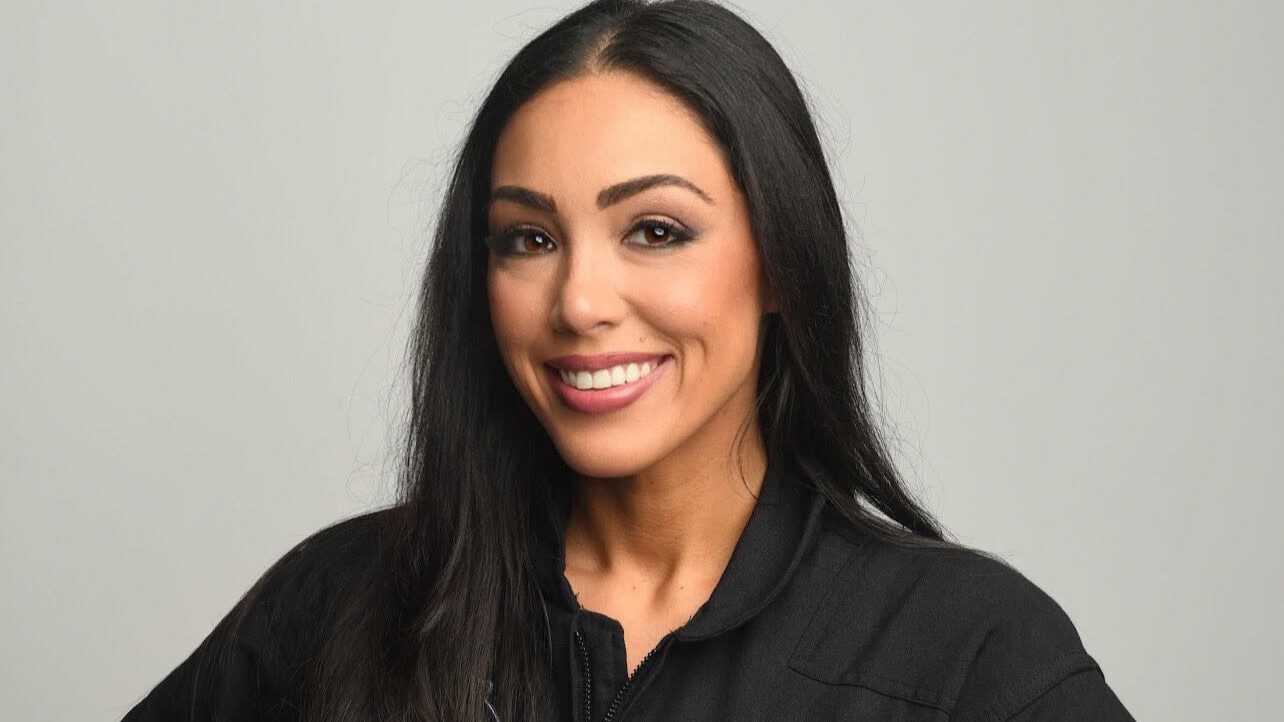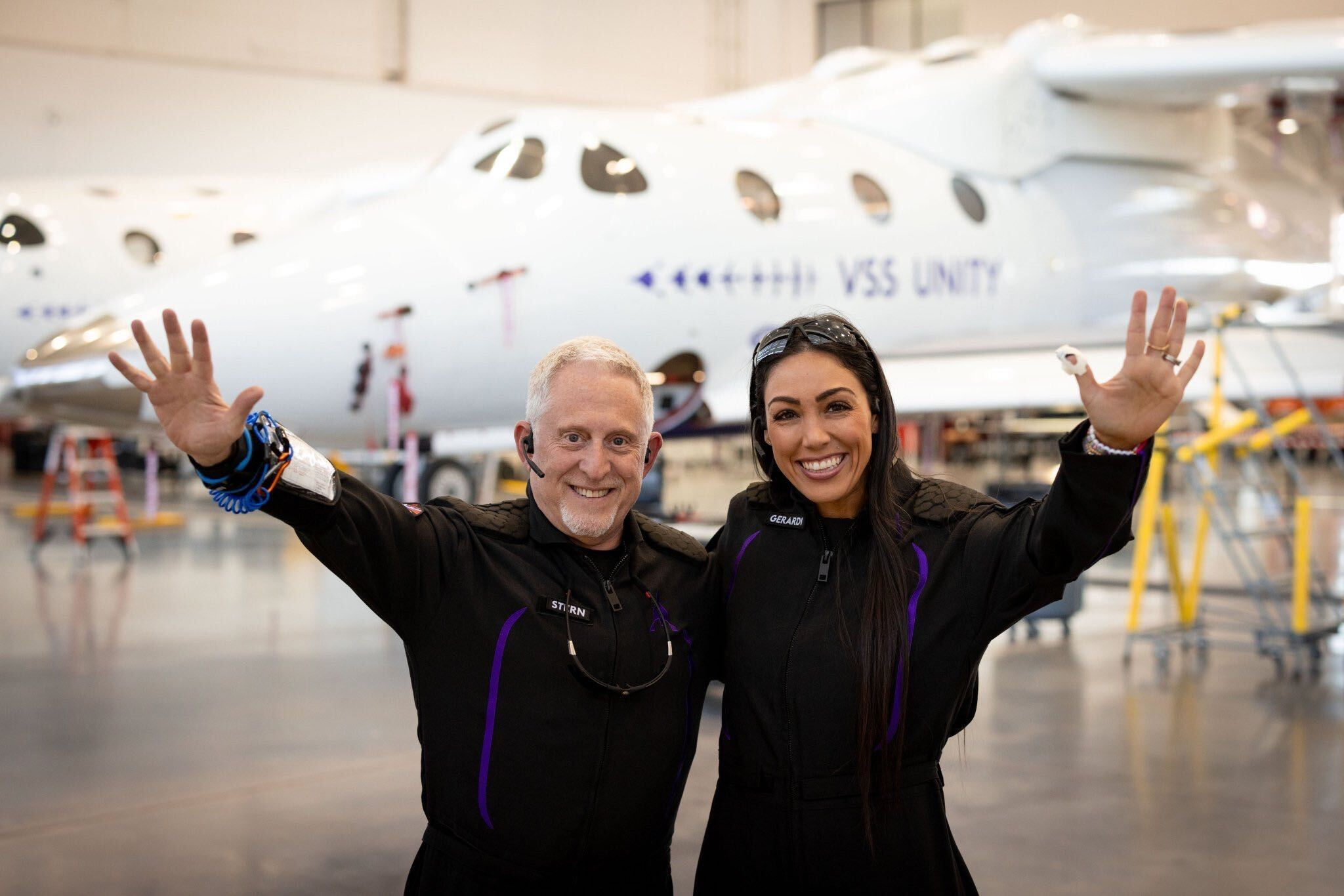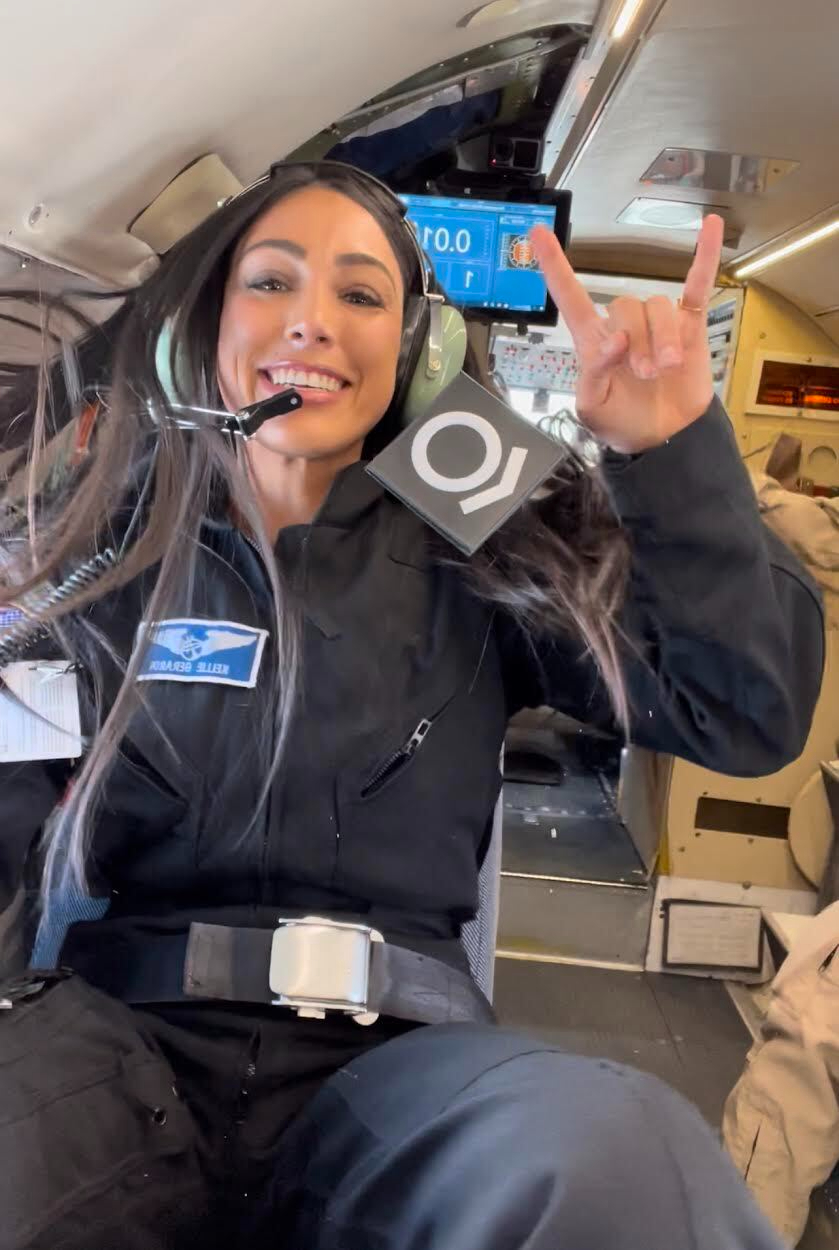Virgin Galactic astronaut Kellie Gerardi is ready for broader access to space
'The limiter has always been access and not aptitude.'

Meet Virgin Galactic astronaut Kellie Gerardi.
She works as mission operations lead for Palantir Technologies and as a payload specialist and bioastronautics researcher for the International Institute for Astronautical Sciences (IIAS). She's also an author, a mom, a social media STEM (science, technology, engineering and math) influencer with a resume of qualifications too long to list and followers who number well over half a million — and now she's headed to space.
Gerardi is a crewmember on Virgin Galactic's fifth commercial spaceflight, Galactic 05. She'll ride aboard the company's VSS Unity space plane as it takes her and other passengers to suborbital space and back on Thursday (Nov. 2).
For Gerardi, Galactic 05 — her first flight to space — represents the culmination of years of hard work and curiosity in the pursuit of astronautical research and the hopes of expanding humanity's reach into the stars. The mission also stands as a new beginning for her and the hundreds of thousands of people who follow her and other STEM communicators online, as access to space grows increasingly tangible for people across the world.
Related: Meet the crew of Virgin Galactic's 5th commercial spaceflight launching on Nov. 2
Girardi has flown scientific missions aboard parabolic jet flights, donned spacesuits in the name of research, experienced altitude and high-g force training, and will now add "astronaut" to her list of accomplishments. She sat down with Space.com before the flight to discuss what it all means for her, and the bigger picture of humanity's access to space.
With your flight imminent, how does it feel knowing you’re about to be one of less than 100 women to ever travel to space?
"It's amazing. To me, the profundity of that [low number] really just drives home the limiter to human spaceflight. The limiter has always been access and not aptitude. Think of how many incredible women are capable today of getting on a spaceship and conducting science in space and are just waiting for that opportunity. I think it really does drive home how important the democratization of access to space is, and what a huge, huge thing that's going to be. It's going to be a really profound change in human spaceflight, not only for women, but for everyone.
"It really feels surreal. I've been imagining this for a very long time. It's been a lifelong dream of mine, which feels like an understatement to say it like that, but the reality of having it here, right in front of me — the preciousness of it affects me daily. It's giving me a lot of motivation to really make sure that my flight is the first of many for my research institute, but also, more broadly, for the next generation of researchers, scientists and civilians. I think this is a really incredible beginning of a new era of access to space, and I want to contribute to that. That's why I started my career in this industry in the first place."
How have you been able to steer your career toward fulfilling your dream of going to space?
"I began my career in the commercial spaceflight industry in 2012. I graduated the year before, when the shuttle program retired, and I learned about the existence of a commercial spaceflight industry and was so intrigued… I really believed in the democratization of access to space and the expansion of Earth's economicsphere, and I wanted to be a part of that — to help create that 'Star Trek' future for the next generation. So I joined Palantir.
"Space has always been the best of humanity. It's always represented, to me, at least, the absolute best of what we can be, and that 'Star Trek' future that I believe we can achieve, but I also know that it’s not a given.
"I wanted to work on contributing solutions to things that might threaten that future. So, the same way I felt called to open up access to space for the next generation, I also felt called to contribute those solutions to my own generation and to anything that would threaten that 'Star Trek' future. That's why I joined Palantir eight years ago, where I lead mission operations. I've had this really incredible support from my team to lead this sort of like Hannah Montana/Miley Cyrus, or Batman/Bruce Wayne, lifestyle with space.
"It's been throughout those years over the last decade I have really been very passionate about bioastronautics research as well. I work with the International Institute for Astronomical Sciences, specifically in microgravity research. We've done a lot of flight campaigns with the National Research Council of Canada, testing technologies with different university partners, or with the Canadian Space Agency, in the example of the Astroskin biomonitor experiment.
"Microgravity flights are awesome and accessible for researchers, just based on the price point, but they're short. You only have so much time before the plane needs to pull up really fast. It's always been the dream to get those continuous, uninterrupted minutes of microgravity exposure, versus seconds, for research. So, I think that this era of access is really cool because it's the 'Goldilocks' solution. The ISS [International Space Station] is so cost-prohibitive, access-limited to research and bottlenecked. And parabolic flights can only get you so many seconds. So, this is sort of the new horizon for researchers like myself, like Dr. Alan Stern, and the next generation of folks who are going to fly with their payloads."

Of the three passengers flying on Galactic 05, Virgin Galactic has so far only announced the names of two: Gerardi and Stern, best known for his role as principal investigator on NASA's New Horizons mission to fly by Pluto and into the Kuiper Belt. Stern's background with NASA is extensive, and his role aboard Galactic 05 will, in part, be in preparation for another flight he will fly for a NASA-funded project.
Get the Space.com Newsletter
Breaking space news, the latest updates on rocket launches, skywatching events and more!
Gerardi's announcement that she would be flying on Galactic 05 was teased online in the weeks preceding the official press release from Virgin Galactic, and was celebrated in several posts across various social media platforms. And, since her flight was made public, Gerardi has brought her audience along for the journey.
Galactic 05 passengers arrived at Spaceport America, in New Mexico, earlier in the week before their flight to complete their training.
Related: New Horizons' Alan Stern will fulfill a lifelong dream on Virgin Galactic spaceflight this week
Ships mated? ✅Research teams onsite? ✅Astronauts in training? ✅Must be a spaceflight week 😎🚀 #Galactic05 is tracking for this Thursday, November 2. pic.twitter.com/D7pIGSIRegOctober 30, 2023
Space and STEM education are very important to everything you do, both professionally and personally, so much so that even your daughter’s name, Delta, serves as an homage to rocket science. How has your relationship with Delta, and witnessing the growth of her own interest in the universe influenced your approach to science communication and the ways you use your platform as a tool for education?
(In the mathematical equation to determine the required thrust a rocket needs to reach orbit, delta-V is the thrust, or change in velocity.)
"The documentation of my personal life in that regard really started out of a fear I had before I became a parent, and if I could make this all work, what it would mean to have a child and to suddenly have to balance all of these different multitudes, and an honest fear about whether or not I could keep all of those plates spinning.
"Then, going through it, I found that it really resonated with a lot of people throughout my pregnancy — the very real kind of fears and anxieties that you have about returning to work, if you can make it all work with childcare and these different aspects of balancing it all, and then being able to show that in a way that was very authentic — I think that is what resonates with so many of the people who have supported me online. Seeing an example of someone making it work is something that I wish that I had seen, and gotten to say, 'OK, that gives me a little more confidence that I can.'
"I did want to be a mother, and I also did want to pursue these other dreams. I am very passionate about my job at Palantir, and all of these things are so important to me. They're like pillars of things I'm passionate about, and I wanted to showcase all of that...
"With the opportunity to actually get to fly to space as a researcher, seeing it through my daughter's eyes is the most profound part of all of this. I think gender schemas get formed very early in life, and my daughter was three when my flight was announced. So, over the last two years, and now leading up to this point where she'll join me right before she turns six at Spaceport [America in New Mexico], in her mind, this is just what moms do. It blows my mind.
"My mom is also joining me at Spaceport. When she was growing up, women were not eligible yet to become astronauts. When she was born, women hadn't yet been to space. So, one generation later, she's watching her own daughter [go to space], and she's watching her granddaughter probably take it for granted. And that's just really cool."

What sort of research will you be doing during your flight?
"I'm doing three experiments.
"One is a fluid experiment. How fluid behaves in a low-gravity environment is very important, both from a safety perspective and also from a scientific and technology perspective. If you remember in 2013 when Luca Parmitano’s helmet flooded during a spacewalk, that was a dramatic showcase of how important it is to understand how fluid behaves in a container in microgravity…
"I'm going to be operating a fluid cell that is designed to help us better predict and control the shape and the location of fluid within a container. I'm going to be working to demonstrate specific fluid states and their class of stability in flight. And that data that we'll get back can help inform new spacecraft life support systems, or syringe designs for administering medication in space. So, that type of data will be really helpful for us.
Another [experiment] is the Astroskin, a wearable sensor system that was developed by Carré Technologies with the support of the Canadian Space Agency, and that's a biomonitoring device. It's worn on Station — by astronauts on the ISS — but my flight will be the first time we’re also collecting data during the launch, reentry and landing portions of flight as well.
"To your point earlier about the low numbers [of women in space], I think that's probably one of the things that's most compelling to me about contributing to this dataset. This is the beginning of a new era of access to space for a broader slice of the population that's less homogenous than, perhaps, the medical profiles of people who have previously flown, and certainly for commercial spaceflight, and also for suborbital spaceflight in particular. Starting to build out a broader dataset of how spaceflight affects the human body is something I'm really interested in contributing to. So that will be great.
"And then there’s the glucose monitoring experiment. This one is personally motivating for me. My mom has been insulin dependent my entire life, and I have a lot of folks on social media who support me who are type-1 diabetics [T1D] themselves, or are parents of T1D kids.
"I'll be wearing a continuous glucose monitor (CGM) during spaceflight. There's some evidence and data that suggests that long-duration spaceflight induces insulin resistance, but there's not a lot of data on how quickly those changes are induced. And now we have this new generation of implantable sensors, and that maybe could give some insight into that.
"I also know a lot of T1D kids who want to be astronauts one day, and the more and more we can expand the sort of datasets and medical profiles of people who fly to space, the better off we'll be.”
Galactic 05 will be Virgin's final mission of 2023, with the company expecting to resume its monthly cadence of suborbital flights in January 2024. The pause, according to Virgin Galactic, will be for routine maintenance and inspections on its VSS Unity space plane and VMS Eve carrier aircraft.
Virgin Galactic does not livestream its commercial missions, but advises monitoring the company's social media channel for updates. The flight is scheduled to take off from the runway at Spaceport America around 9 a.m. MDT (10 a.m. ET/1400 GMT), and it will likely last about 1.5 hours.
Join our Space Forums to keep talking space on the latest missions, night sky and more! And if you have a news tip, correction or comment, let us know at: community@space.com.

Josh Dinner is the Staff Writer for Spaceflight at Space.com. He is a writer and photographer with a passion for science and space exploration, and has been working the space beat since 2016. Josh has covered the evolution of NASA's commercial spaceflight partnerships and crewed missions from the Space Coast, as well as NASA science missions and more. He also enjoys building 1:144-scale model rockets and human-flown spacecraft. Find some of Josh's launch photography on Instagram and his website, and follow him on X, where he mostly posts in haiku.









